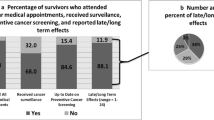Abstract
Purpose
Cancer survivors require follow-up care to ensure early detection of recurrence, management of late/long term effects, preventive screening for early detection of second primary malignancies, as well as other forms of preventive care. But not all survivors receive necessary follow-up care. Combining survivorship care plans and patient navigation may be a successful strategy to improve survivor’s receipt of necessary follow-up care.
Methods
Using data from the 2010 LIVESTRONG online survey of cancer survivors (N = 3854), this study tested associations between receipt of follow-up care instructions (FCI) and treatment summaries (TS) paired with patient navigation (PN), and survivor’s receipt of cancer surveillance, preventive cancer screening, and attendance at regular medical appointments.
Results
Survivors who received FCI, TS, and patient navigation were the most likely to report attendance at all medical appointments (aOR 4.17, 95 % CI 2.30, 7.57, p ≤ .001) and receipt of preventive cancer screening (aOR 3.56, 95 % CI 2.28, 5.55, p ≤ .001).
Conclusions
Likelihood of receiving follow-up care was greatest when survivors received FCI, TS, and PN. This pairing appeared to be most beneficial for survivor’s attendance at medical appointments and receipt of preventive cancer screening.
Implications for cancer survivors
By improving attendance at medical appointments and prevention cancer screening, pairing SCP and PN could benefit survivors through reduced recurrence, earlier recurrence detection, and prevention of second primaries.

Similar content being viewed by others
References
American Cancer Society. Cancer Treatment & Survivorship. Facts & Figures 2014-2015. Atlanta: American Cancer Society; 2014.
American Cancer Society. Cancer Facts & Figures 2013. Atlanta: American Cancer Society; 2013.
Underwood JM, Townsend JS, Steweart SL, Buchannan N, Ekwueme DU, Hawkins NA, et al. Surveillance of demographic characteristics and health behaviors among adult cancer survivors—Behavioral Risk Factor Surveillance System, United States, 2009. MMWR. 2012;61(1):1–23.
Snyder CF et al. Prevention, screening, and surveillance care for breast cancer survivors compared with controls: changes from 1998 to 2002. J Clin Oncol. 2009;27(7):1054–61.
Institute of Medicine (IOM). From cancer patient to cancer survivor: lost in transition. In: Hewitt M, Greenfield S, Stovall E, editors. The National Academies Press; 2005.
American College of Surgeons. Commission on cancer. 2011 [cited 2012 June]; Available from: http://inspiringquality.facs.org/about/commission-on-cancer/.
LIVESTRONG and The Centers for Disease Control and Prevention, National Action Plan for Cancer Survivorship: Advancing Public Health Strategies. 2004.
Ganz PA, Casillas J, Hahn EE. Ensuring quality care for cancer survivors: implementing the survivorship care plan. Semin Oncol Nurs. 2008;24(3):208–17.
Earle CC. Long term care planning for cancer survivors: a health services research agenda. J Cancer Surviv. 2007;1(1):64–74.
Sabatino S, et al. Receipt of cancer treatment summaries and follow-up instructions among adult cancer survivors: results from a national survey. J Cancer Surviv. 2012; p. 1-12.
Jabson JM. Follow-up care instructions, treatment summaries, and cancer survivors’ receipt of follow-up health care and late/long term effects. Support Care Cancer. 2014.
Grunfeld E, Julian JA, Pond G, Maunsell E, Coyle D, Folkes A, et al. Evaluating survivorship care plans: results of a randomized clinical trial of patients with breast cancer. J Clin Oncol. 2011;29:1–8.
Brothers BM et al. Do survivorship care plans impact patients’ evaluations of care? A randomized evaluation with gynecologic oncology patients. Gynecol Oncol. 2013;129(3):554–8.
Jabson JM, Bowen DJ, How do follow-up care instructions and treatment summaries relate to cancer survivors’ cancer-related pain? J Pain Symptom Manag. 2014.
Freeman HP, Rodriguez RL. History and principles of patient navigation. Cancer. 2011;117(15 Suppl):3539–42.
Paskett ED, Harrop JP, Wells KJ. Patient navigation: an update on the state of the science. CA Cancer J Clin. 2011;61(4):237–49.
Eschiti V, Burhansstipanov L, Watanabe-Galloway S. Native cancer navigation: the state of the science. Clin J Oncol Nurs. 2012;16(1):73–82.
Rechis R, Reynolds KA, Beckjord EB, Nutt S, Burns RM, Schoefer JS. LIVESTRONG Report, 2010. TX: LiveSTRONG Austin; 2011.
Freeman HP. Patient navigation: a community-based strategy to reduce cancer disparities. J Urban Health. 2006;83(2):139–41.
Pinsky PF et al. Evidence of a healthy volunteer effect in the prostate, lung, colorectal, and ovarian cancer screening trial. Am J Epidemiol. 2007;165(8):874–81.
Conflict of interest
The author declares that she has no conflict of interest.
Author information
Authors and Affiliations
Corresponding author
Rights and permissions
About this article
Cite this article
Jabson, J.M. Treatment summaries, follow-up care instructions, and patient navigation: could they be combined to improve cancer survivor’s receipt of follow-up care?. J Cancer Surviv 9, 692–698 (2015). https://doi.org/10.1007/s11764-015-0444-0
Received:
Accepted:
Published:
Issue Date:
DOI: https://doi.org/10.1007/s11764-015-0444-0



